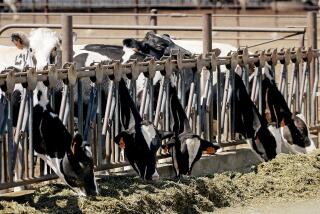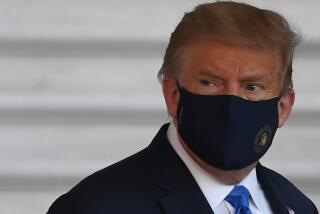Hog Farmers Fear Fallout From Mad Cow Case
- Share via
Pigs don’t fly, and they don’t get mad cow disease. But that’s little consolation to hog farmers.
Already sweating depressed prices, U.S. pork producers are bracing for a shock wave that could hammer the value of ham, bacon and sausage in the coming months as the nation’s single case of mad cow disease sends ripples across the livestock industry.
“This is my fear,” said Bob Larson, who tends 14,000 hogs near Sioux Falls, S.D.
Larson remembers the dominoes that fell in Canada after bovine spongiform encephalopathy, or BSE, better known as mad cow disease, was found in a beef cow in Alberta in May.
Trading partners banned Canadian beef, which was rerouted to a saturated domestic market. Beef prices tumbled. Canadians loaded up, eschewing pork. As demand for pork fell, so did prices. Pork producers’ margins started shrinking. Processing plants cut back on workers’ hours; one plant shut down.
Some of the same dynamics are starting to be seen in the United States.
Cattle prices have fallen 13% since Dec. 23, when BSE was detected in a Canadian-born dairy cow in Washington state. Major importers, including Japan and South Korea, have closed their borders to American beef.
The meat they would have purchased -- last year the estimated $3.5 billion worth of beef sent overseas represented 10% of total U.S. production -- is now headed for grocery counters around the country. And within the next few weeks, said Erica Rosa, an economist at the Livestock Marketing Information Center in Lakewood, Colo., consumers should expect to see lower prices for steak and hamburger.
“There is just no way Americans will eat 10% more beef unless you drop prices substantially,” said Dermot Hayes, an agribusiness professor at Iowa State University.
That’s what makes hog farmers so nervous. Right now, prime rib sells for $7 to $9 a pound, while pork loin goes for $2 to $4 a pound. If Americans see the price of beef getting a trim, they may start turning their backs on what the National Pork Board calls “the other white meat.”
Last week, as Betty Sheller perused the selection at Marconda’s Meats at the Farmers Market in the Fairfax district, she saw everything from red sirloins at $12.98 a pound to richly marbled prime-grade porterhouse steaks for $20.98. She settled for ground round and pot roast, both at $2.49 a pound.
“Beef is so expensive right now,” said Sheller, who often opts for pork and poultry to stay within her budget. If prices were lower, Sheller said she definitely would buy more beef.
Despite the mad cow scare, so far there’s little evidence Americans are shunning beef for health reasons. In fact, the Atkins diet fad has reignited the country’s love affair with red meat, and that helped push the average retail price of a boneless sirloin steak last year to $6.93 a pound, up 27% from 2002, according to the U.S. Department of Agriculture.
This month, the USDA said domestic per capita beef consumption might hit 67.8 pounds this year, up 3.4 pounds from 2003, based on the expectation that beef prices would continue to fall.
Paul Ackley, who owns 2,000 pigs in Bedford, Iowa, recalled how different things were just two months ago, when he dined out at a Western Sizzlin restaurant in Enid, Okla.
“That’s beef country, and I was surprised to see they were featuring [pork] chops for $7 and $7.50,” Ackley said, adding that he figured the restaurant needed an entree that was less expensive than its steak offerings, which were about $10 each. “When beef prices come down, they aren’t going to be doing that anymore.”
Hayes figures U.S. hog prices could fall by as much as 6% this year, based on the amount of beef that suddenly must be absorbed by the domestic market. (His estimate is calculated under a formula called cross-price flexibility that holds that a 10% increase in the beef supply causes people to eat 3% less pork, and that a 3% drop in pork demand sends prices down 6%.)
Before the discovery of the infected dairy cow in Washington, February lean-hog futures were trading in the $56-to-$60 range, which Hayes called a break-even level for most producers. Since then, the futures have been trading in the $52-to-$56 range.
Matters are about to get worse for U.S. pork producers: The USDA estimates that more than 101 million hogs will be butchered this year, possibly the biggest slaughter ever.
On top of that, some of the pork Canadians aren’t eating is being exported -- to the United States.
“Canada has just flooded the U.S. market with pork, and now we are going to see lower beef prices here,” said Wayne Demmer, who raises 3,000 pigs and 500 cattle on a ranch 15 miles west of Dubuque, Iowa. “It is going to be hard to get a decent price for anything coming out of here.”
There is a bright spot: The low value of the dollar and foreign countries’ need to find replacements for banned U.S. beef will combine for a 7% increase in U.S. pork exports, to 1.3 billion pounds this year, according to the USDA. Hayes said increased exports had kept lean-hog prices from falling further.
The degree to which U.S. livestock markets will be thrown off by mad cow disease isn’t clear, economists said. To be sure, the effect here isn’t likely to be anywhere as severe as it has been in Canada because its industry is so much more dependent on exports.
“Canada had to find a home for half of its production,” said James Mintert, an agricultural economist at Kansas State University.
For the U.S. pork industry -- and the beef industry, of course -- the wild card is Japan, which was the biggest foreign buyer of U.S. beef last year, accounting for about 37% of U.S. exports, or $1 billion in purchases. U.S. commodity markets have been pricing beef as if the ban by Japan and other countries will be short, Mintert said. But the market may be underestimating Japan’s view of the U.S. mad cow scare.
Eight months after it stopped buying Canadian beef, Japan still hasn’t lifted that ban. And last week, Japan’s farm ministry warned that U.S. measures to prevent BSE-infected beef from entering the food chain weren’t enough for Tokyo.
“Right now, the signals are bad,” said Hayes of Iowa State, “and the longer we are out of the export markets, the worse things will be.”
More to Read
Sign up for Essential California
The most important California stories and recommendations in your inbox every morning.
You may occasionally receive promotional content from the Los Angeles Times.














